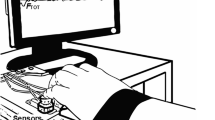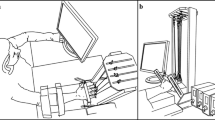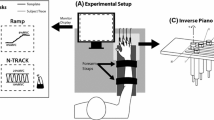Abstract
We used two methods to address two aspects of multi-finger synergies and their changes after fatigue of the index finger. Analytical inverse optimization (ANIO) was used to identify cost functions and corresponding spaces of optimal solutions over a broad range of task parameters. Analysis within the uncontrolled manifold (UCM) hypothesis was used to quantify co-variation of finger forces across repetitive trials that helped reduce variability of (stabilized) performance variables produced by all the fingers together. Subjects produced steady-state levels of total force and moment of force simultaneously as accurately as possible by pressing with the four fingers of the right hand. Both before and during fatigue, the subjects performed single trials for many force–moment combinations covering a broad range; the data were used for the ANIO analysis. Multiple trials were performed at two force–moment combinations; these data were used for analysis within the UCM hypothesis. Fatigue was induced by 1-min maximal voluntary contraction exercise by the index finger. Principal component (PC) analysis showed that the first two PCs explained over 90% of the total variance both before and during fatigue. Hence, experimental observations formed a plane in the four-dimensional finger force space both before and during fatigue conditions. Based on this finding, quadratic cost functions with linear terms were estimated from the experimental data. The dihedral angle between the plane of optimal solutions and the plane of experimental observations (D ANGLE) was very small (a few degrees); it increased during fatigue. There was an increase in fatigue of the coefficient at the quadratic term for the index finger force balanced by a drop in the coefficients for the ring and middle fingers. Within each finger pair (index–middle and ring–little), the contribution of the “central” fingers to moment production increased during fatigue. An index of antagonist moment production dropped with fatigue. Fatigue led to higher co-variation indices during pronation tasks (index finger is an agonist) but opposite effects during supination tasks. The results suggest that adaptive changes in co-variation indices that help stabilize performance may depend on the role of the fatigued element, agonist or antagonist.








Similar content being viewed by others
References
Ait-Haddou R, Jinha A, Herzog W, Binding P (2004) Analysis of the force-sharing problem using an optimization model. Math Biosci 191:111–122
Allen TJ, Proske U (2006) Effect of muscle fatigue on the sense of limb position and movement. Exp Brain Res 170:30–38
Carpentier A, Duchateau J, Hainaut K (2001) Motor unit behaviour and contractile changes during fatigue in the human first dorsal interosseus. J Physiol 534:903–912
Christou EA, Grossman M, Carlton LG (2002) Modeling variability of force during isometric contractions of the quadriceps femoris. J Mot Behav 34:67–81
Contessa P, Adam A, De Luca CJ (2009) Motor unit control and force fluctuation during fatigue. J Appl Physiol 107:235–243
Côté JN, Mathieu PA, Levin MF, Feldman AG (2002) Movement reorganization to compensate for fatigue during sawing. Exp Brain Res 146:394–398
Côté JN, Feldman AG, Mathieu PA, Levin MF (2008) Effects of fatigue on intermuscular coordination during repetitive hammering. Mot Control 12:79–92
Danion F, Latash ML, Li ZM, Zatsiorsky VM (2000) The effect of fatigue on multifinger co-ordination in force production tasks in humans. J Physiol 523(Pt 2):523–532
Danion F, Latash ML, Li ZM, Zatsiorsky VM (2001) The effect of a fatiguing exercise by the index finger on single- and multi-finger force production tasks. Exp Brain Res 138:322–329
Danion F, Schöner G, Latash ML, Li S, Scholz JP, Zatsiorsky VM (2003) A mode hypothesis for finger interaction during multi-finger force-production tasks. Biol Cybern 88:91–98
Enoka RM, Duchateau J (2008) Muscle fatigue: what, why and how it influences muscle function. J Physiol 586:11–23
Enoka RM, Baudry S, Rudroff T, Farina D, Klass M, Duchateau J (2011) Unraveling the neurophysiology of muscle fatigue. J Electromyogr Kinesiol 21:208–219
Evans RK, Scoville CR, Ito MA, Mello RP (2003) Upper body fatiguing exercise and shooting performance. Mil Med 168:451–456
Forestier N, Nougier V (1998) The effects of muscular fatigue on the coordination of a multijoint movement in human. Neurosci Lett 252:187–190
Fuller JR, Lomond KV, Fung J, Côté JN (2009) Posture-movement changes following repetitive motion-induced shoulder muscle fatigue. J Electromyogr Kinesiol 19:1043–1052
Gates DH, Dingwell JB (2008) The effects of neuromuscular fatigue on task performance during repetitive goal-directed movements. Exp Brain Res 187:573–585
Gera G, Freitas S, Latash M, Monahan K, Schöner G, Scholz J (2010) Motor abundance contributes to resolving multiple kinematic task constraints. Mot Control 14:83–115
Gorniak SL, Duarte M, Latash ML (2008) Do synergies improve accuracy? A study of speed-accuracy trade-offs during finger force production. Mot Control 12:151–172
Granata KP, Marras WS, Davis KG (1999) Variation in spinal load and trunk dynamics during repeated lifting exertions. Clin Biomech 14:367–375
Huffenus AF, Amarantini D, Forestier N (2006) Effects of distal and proximal arm muscles fatigue on multi-joint movement organization. Exp Brain Res 170:438–447
Kadefors R, Petersen I, Herberts P (1976) Muscular reaction to welding work: an electromyographic investigation. Ergonomics 19:543–548
Kaiser HF (1960) The application of electronic computers to factor analysis. Psychol Meas 20:141–151
Kang N, Shinohara M, Zatsiorsky VM, Latash ML (2004) Learning multi-finger synergies: an uncontrolled manifold analysis. Exp Brain Res 157:336–350
Kruger ES, Hoopes JA, Cordial RJ, Li S (2007) Error compensation during finger force production after one- and four-finger voluntarily fatiguing exercise. Exp Brain Res 181:461–468
Latash ML (2010) Motor synergies and the equilibrium-point hypothesis. Mot Control 14:294–322
Latash ML, Scholz JF, Danion F, Schöner G (2001) Structure of motor variability in marginally redundant multifinger force production tasks. Exp Brain Res 141:153–165
Latash ML, Scholz JP, Schöner G (2002) Motor control strategies revealed in the structure of motor variability. Exerc Sport Sci Rev 30:26–31
Latash ML, Scholz JP, Schöner G (2007) Toward a new theory of motor synergies. Mot Control 11:276–308
Li ZM, Latash ML, Zatsiorsky VM (1998) Force sharing among fingers as a model of the redundancy problem. Exp Brain Res 119:276–286
Li ZM, Zatsiorsky VM, Latash ML, Bose NK (2002) Anatomically and experimentally based neural networks modeling force coordination in static multi-finger tasks. Neurocomputing 47:259–275
Madeleine P, Madsen TM (2009) Changes in the amount and structure of motor variability during a deboning process are associated with work experience and neck-shoulder discomfort. Appl Ergonom 40:887–894
Madeleine P, Voigt M, Mathiassen SE (2008) The size of cycle-to-cycle variability in biomechanical exposure among butchers performing a standardised cutting task. Ergonomics 51:1078–1095
Missenard O, Mottet D, Perrey S (2008) Muscular fatigue increases signal-dependent noise during isometric force production. Neurosci Lett 437:154–157
Missenard O, Mottet D, Perrey S (2009) Factors responsible for force steadiness impairment with fatigue. Muscle Nerve 40:1019–1032
Newell KM, Carlton LG (1988) Force variability in isometric responses. J Exp Psychol Hum Percept Perform 14:37–44
Nubar Y, Contini R (1961) A minimal principle in biomechanics. Bull Math Biophys 23:377–391
Olafsdottir H, Zhang W, Zatsiorsky VM, Latash ML (2007) Age-related changes in multifinger synergies in accurate moment of force production tasks. J Appl Physiol 102:1490–1501
Park J, Zatsiorsky VM, Latash ML (2010) Optimality vs. variability: an example of multi-finger redundant tasks. Exp Brain Res 207:119–132
Park J, Sun Y, Zatsiorsky VM, Latash ML (2011a) Age-related changes in optimality and motor variability: an example of multifinger redundant tasks. Exp Brain Res 212:1–18
Park J, Zatsiorsky VM, Latash ML (2011b) Finger coordination under artificial changes in finger strength feedback: a study using analytical inverse optimization. J Mot Behav 43:229–235
Prilutsky BI, Zatsiorsky VM (2002) Optimization-based models of muscle coordination. Exerc Sport Sci Rev 30:32–38
Rosenbaum DA, Meulenbroek RJ, Vaughan J, Jansen C (2001) Posture-based motion planning: applications to grasping. Psychol Rev 108:709–734
Scholz JP, Schöner G (1999) The uncontrolled manifold concept: identifying control variables for a functional task. Exp Brain Res 126:289–306
Scholz JP, Danion F, Latash ML, Schöner G (2002) Understanding finger coordination through analysis of the structure of force variability. Biol Cybern 86:29–39
Shapkova EY, Shapkova AL, Goodman SR, Zatsiorsky VM, Latash ML (2008) Do synergies decrease force variability? A study of single-finger and multi-finger force production. Exp Brain Res 188:411–425
Shim JK, Latash ML, Zatsiorsky VM (2005) Prehension synergies in three dimensions. J Neurophysiol 93:766–776
Singh T, Latash ML (2011) Effects of muscle fatigue on multi-muscle synergies. Exp Brain Res 214:335–350
Singh T, SKM V, Zatsiorsky VM, Latash ML (2010a) Adaptive increase in force variance during fatigue in tasks with low redundancy. Neurosci Lett 485:204–207
Singh T, SKM V, Zatsiorsky VM, Latash ML (2010b) Fatigue and motor redundancy: adaptive increase in finger force variance in multi-finger tasks. J Neurophysiol 103:2990–3000
Terekhov AV, Zatsiorsky VM (2011) Analytical and numerical analysis of inverse optimization problems: conditions of uniqueness and computational methods. Biol Cybern 104:75–93
Terekhov AV, Pesin YB, Niu X, Latash ML, Zatsiorsky VM (2010) An analytical approach to the problem of inverse optimization with additive objective functions: an application to human prehension. J Math Biol 61:423–453
Zatsiorsky VM, Latash ML (2004) Prehension synergies. Exerc Sport Sci Rev 32:75–80
Zatsiorsky VM, Li ZM, Latash ML (1998) Coordinated force production in multi-finger tasks: finger interaction and neural network modeling. Biol Cybern 79:139–150
Zatsiorsky VM, Gregory RW, Latash ML (2002a) Force and torque production in static multifinger prehension: biomechanics and control. I. Biomechanics Biol Cybern 87:50–57
Zatsiorsky VM, Gregory RW, Latash ML (2002b) Force and torque production in static multifinger prehension: biomechanics and contro. II. Control. Biol Cybern 87:40–49
Zatsiorsky VM, Gao F, Latash ML (2003) Prehension synergies: effects of object geometry and prescribed torques. Exp Brain Res 148:77–87
Zhang W, Scholz JP, Zatsiorsky VM, Latash ML (2008) What do synergies do? Effects of secondary constraints on multidigit synergies in accurate force-production tasks. J Neurophysiol 99:500–513
Acknowledgments
We are grateful to Dr. Alexander Terekhov for his advice. The study was supported in part by NIH grants AG-018751, NS-035032, and AR-048563.
Author information
Authors and Affiliations
Corresponding author
Appendices
Appendix 1
Analytical inverse optimization (ANIO) approach
The optimization problem in the current study was defined as
The two linear constraints are expressed as
The task involved two constraints (F TOT and M TOT values) and four elemental variables (finger forces). Thus, the solutions of this undetermined system were expected to be confined to a two-dimensional surface in the four-dimensional force space. Planarity of this surface was checked using the PCA. The following computational procedure explains how the optimization cost function is obtained.
First, we identify whether the optimization problem is splittable or not by observing the (4 × 4) matrix:
Second, we check whether the experimental data actually lie on a hyperplane (and not for instance on a curved hypersurface) and then define the observed hyperplane mathematically as
where A is a 2 × 4 matrix composed of the transposed vectors of the two lesser principal components obtained from the PCA from the finger force data. A large percentage of the total variance explained by the two first principal components was considered an indicator that the data lie on a hyperplane. However, the data points were not perfectly confined to a plane due to the variability of performance and instrumental noise. Also, the plane computed from Eq. 13 is affected by experimental errors.
Third, we compare the experimentally determined hyperplane to the theoretical plane derived from the uniqueness theorem. The experimental data must be fitted by the following equation:
where \( f^{\prime } (F) = (f_{1}^{\prime } (F_{\rm I} ),f_{2}^{\prime } (F_{\rm M} ),f_{3}^{\prime } (F_{\rm R} ),f_{4}^{\prime } (F_{\rm L} ))^{T} \) f i are arbitrary continuously differentiable functions. At the second step, the data are discovered to lie on the plane and hence the function \( f_{i}^{\prime } ( \cdot ) \) is linear:
where i = {index (I), middle (M), ring (R), and little (L)}. Therefore,
The values of the coefficients of the second-order terms k i can be determined by minimizing the dihedral angle between the two planes: the plane of optimal solutions \( \overset{\lower0.5em\hbox{$\smash{\scriptscriptstyle\smile}$}}{C} f^{\prime } (F) = 0 \) and the plane of experimental observations (A · F T = 0). The values of the coefficients of the first-order terms w i were found to correspond to a minimal vector length (w = (w index, w middle, w ring, w little)T) bringing the theoretical and the experimental plane as close to each other as possible. Vector w satisfy the following equation:
where K = (k I , k M , k R , k L)T and w = (w I , w M , w R , w L)T.
Then, the functions g i in Eq. 12 are the following:
where r is a non-zero number, const i can be any real number and q i is any real number satisfying the equation \( \overset{\lower0.5em\hbox{$\smash{\scriptscriptstyle\smile}$}}{C} q = 0 \) (Terekhov et al. 2010). Multiplication of the cost function by a constant value or adding a constant value to it does change the cost function essentially. Hence, we can arbitrarily assume that r = 1 and consti = 0. According to the uniqueness theorem, identification of the cost function can be performed only up to unknown linear terms that are parameterized by the values qi. We assume that qi = 0 in order to simplify gi(xi). It must be kept in mind, however, that the true cost function used by the CNS might have these terms.
Uniqueness theorem (for the mathematical proof see Terekhov et al. 2010)
The core of the ANIO approach is the theorem of uniqueness that specifies conditions for unique (with some restrictions) estimation of the objective functions. The main idea of the theorem of uniqueness is to find necessary conditions for the uniqueness of solutions in an inverse optimization problem. An optimization problem (i.e., direct optimization problem) with an additive objective function and linear constraints is defined as
where X = (x 1, x 2,…, x n) ∈ R n, g i is an unknown scalar differentiable function with g′(⋅) > 0. g i came from the Lagrange minimum principle, which has a unique solution. On the contrary, the functions of g i can be computed from the set of solutions X * (e.g., experimental data). This inverse procedure is called the inverse optimization problem. C is a k × n matrix and B is a k-dimension vector, k < n.
First, assume that the optimization problem (19) with k ≥ 2 is non-splittable. If the inverse optimization is splittable, the preliminary step is to split it until a non-splittable subproblem is acquired. If the functions g i (x i ) in problem (19) are twice continuously differentiable (i.e., twice continuously differentiable functions f i ) and \( f_{i}^{\prime } \) is not identically constant, complying \( \overset{\lower0.5em\hbox{$\smash{\scriptscriptstyle\smile}$}}{C} f^{\prime } (X) = 0 \) for all X ∈ X *,
and
then
for every \( x_{i} \in X_{i}^{*} \), where \( X_{i}^{*} \) = {s| there is X ∈ X *: x i ∈ s} and X * is the set of the solutions for all B ∈ R k. The constants q i satisfy the equation \( \overset{\lower0.5em\hbox{$\smash{\scriptscriptstyle\smile}$}}{C} q = 0 \) where \( q = (q_{1} , \ldots ,q_{n} )^{T} \). Primes designate derivatives.
If the experimental data correspond to solutions of an inverse optimization problem with additive objective function (g i ) and linear constraints, equation \( \overset{\lower0.5em\hbox{$\smash{\scriptscriptstyle\smile}$}}{C} f^{\prime } (X) = 0 \) (X ∈ X *) must be satisfied (i.e., the Lagrange principle). The uniqueness theorem provides sufficient condition (i.e., \( \overset{\lower0.5em\hbox{$\smash{\scriptscriptstyle\smile}$}}{C} f^{\prime } (X) = 0 \)) for solving the inverse optimization problem in a unique way up to linear terms.
Appendix 2
Uncontrolled manifold (UCM) analysis (see Latash et al. 2002; Scholz et al. 2002 for details)
For F TOT, changes in the elemental variables (finger forces) sum up to produce a change in F TOT:
The UCM was defined as an orthogonal set of the vectors e i in the space of the elemental forces that did not change the net normal force, i.e.,
These directions were found by taking the null-space of the Jacobian of this transformation ([1 1 1 1] e i ). The mean-free forces were then projected onto these directions and summed to produce
where n = 4 is the number of degrees of freedom of the elemental variables and P = 1 is the number of degrees of freedom of the performance variable (F TOT). The component of the de-meaned forces orthogonal to the null-space is given by
The amount of variance per degree of freedom parallel to the UCM is
The amount of variance per degree of freedom orthogonal to the UCM is
The normalized difference between these variances is quantified by a variable ΔV:
where V TOT is the total variance, also quantified per degree of freedom. If ΔV is positive, V UCM > V ORT, caused by negative co-variation of the finger forces, which we interpret as evidence for a force-stabilizing synergy. In contrast, ΔV = 0 indicates independent variation of the finger forces, while ΔV < 0 indicates positive co-variation of the individual finger forces, which contributes to variance of F TOT.
A similar procedure was used to compute the two variance components related to stabilization of M TOT. The only difference was in using a different Jacobian corresponding to the lever arms of individual finger forces, [d I d M d R d L].
We also analyzed the data with respect to stabilization of both F TOT and M TOT simultaneously. In that case, the Jacobian was [1 1 1 1; d I d M d R d L]. The dimensionality of V UCM for the analysis with respect to F TOT and M TOT separately is three (one constraint), while the dimensionality of V UCM with respect to F TOT and M TOT simultaneously is two (two constraints).
Rights and permissions
About this article
Cite this article
Park, J., Singh, T., Zatsiorsky, V.M. et al. Optimality versus variability: effect of fatigue in multi-finger redundant tasks. Exp Brain Res 216, 591–607 (2012). https://doi.org/10.1007/s00221-011-2963-x
Received:
Accepted:
Published:
Issue Date:
DOI: https://doi.org/10.1007/s00221-011-2963-x




